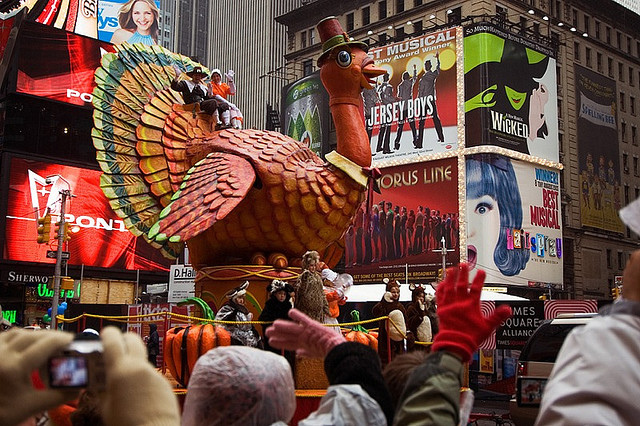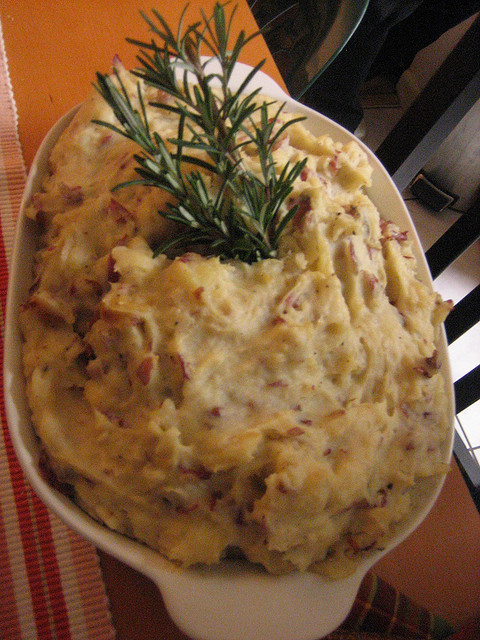Feeling gratitude and not expressing it is like wrapping a present and not giving it.
- William Arthur Ward
Thanksgiving Day, is the day when one express gratitude for all the kindness they have received. The day signifies commemorating (the first Thanksgiving offered at Plymouth, Mass. in 1621), symbolism (the meal includes dishes which were consumed on the first Thanksgiving, expression of gratitude (for the kindness received) and love and bonding between families.
A Vintage Thanksgiving Day Card
Author - Dave, Source -
Flickr
The festival (celebrated on the fourth Thursday of November in the United States) is a holiday celebrated mainly in the United States of America and Canada (apart from Liberia and Norfolk Island). Both the country's festivals have different origins. Originally the Thanksgiving began as a tradition of celebrating the harvest of the year. As per the longstanding traditions of the holiday in the United States, the celebration often extends to the weekend that falls closest to the day it is celebrated.
Origin of Thanksgiving Day -
The origin of the first celebration in the United States was recorded at Virginia in 1619 (prompted by the colonists' leaders on the anniversary of the first settlement). But the feast for Thanksgiving in 1621 at Plymouth (in Massachusetts, New England) was prompted by a good harvest and is considered by many as the actual event which inspired the celebrations.
A roast turkey is a symbol of major celebrations. Its presence on the dining table at Thanksgiving Day is customary. Traditionally(but not necessarily) the head of the family carves out portions for the rest of members at the table.
Author - Patrick Fitzgerald Source -
Flickr
In the year 1620, a boat filled with more than one hundred people sailed from Europe to settle in the New World. This religious group had begun to question the beliefs of the Church of England and wanted to separate from it. The Pilgrims settled in what is now the state of Massachusetts(New England). Their first winter in the New World was difficult. They had arrived too late to grow sufficient crops, and without fresh food, half the colony died from disease. The following spring the Iroquois Indians taught them how to grow corn (maize), a new food for the colonists. They showed them other crops to grow in the unfamiliar soil and how to hunt and fish.
Home Made Roasted Turkey, just out of the oven
Author - Shoshanah Source -
Flickr
In the autumn of 1621, bountiful crops of corn, barley, beans and pumpkins were harvested. The colonists had much to be thankful for, so a feast was planned. They invited the local Indian chief and approximately 90 Indians. The Indians brought deer to roast with the turkeys and other wild game offered by the colonists. The colonists had learned how to cook cranberries and different kinds of corn and squash dishes from the Indians.In the following years, many of the original colonists celebrated the autumn harvest with a feast of thanks.
How the Date of the Celebration was decided -
After the United States became independent, the Congress recommended an annual day of thanksgiving for the whole nation to celebrate. George Washington suggested the date November 26 as Thanksgiving Day. Then in 1863, at the end of a long and bloody civil war, Abraham Lincoln asked all Americans to set aside the last Thursday in November as a day of thanksgiving.
But in the year 1939 US President Franklin D. Roosevelt changed the date and set it one week earlier as he wanted to help business by lengthening the shopping period before Christmas. Congress ruled that after 1941 the 4th Thursday in November would be a federal holiday proclaimed by the President each year.
Home Made Cranberry Sauce
Author - Shoshanah Source -
FlickrThanksgiving is a time for tradition and sharing. Even if they live far away, members gather for a 'family reunion' at the house of an older relative. All give thanks and pray together for the good things and blessings that they have got. Families enjoy watching the Macy's Thanksgiving Day Parade held in New York on TV across the country. Some families also participate in a Turkey Trot Run or Have a Mini Pumpkin Hunt amongst other activities.
In this spirit of sharing, charitable organizations offer a traditional meal to those in need, particularly the homeless. On most tables throughout the United States, the food eaten at the first thanksgiving have become traditional.
A slice of Pumpkin Pie. A traditional meal at Thanksgiving will always include a Pumpkin Pie
Author - Paul Sullivan Source -
Flickr
The Parade's -
Annual
Thanksgiving Day Parades are held across various cities amongst which
the Macy's Thanksgiving Day Parade (New York), America's Thanksgiving
Day Parade (Detroit) and the 6abc Dunkin Donuts Thanksgiving Parade
(formerly known as Gimbels Thanksgiving Day Parade) (Boston) are the
oldest.
Author - Ian Gampon, Source - Flickr
A Thanksgiving Day is considered incomplete without a Turkey
Author - martha_chapa95 Source - Flickr
Thanksgiving Day Feast -
Turkey, corn (or maize), pumpkins and cranberry sauce are symbols which represent the first Thanksgiving Feast. Now all of these symbols are drawn on holiday decorations and greeting cards. The use of corn meant the survival of the colonies. "Indian corn" as a table or door decoration represents the harvest and the fall season.
A usual Thanksgiving Day meal
consists of Roasted Turkey, bowl of Cranberry Sauce(perfect
accompaniment with turkey), Yeast Rolls, A Walnut preparation for dessert
Author - Cheryl Source -
Flickr
Roasted Garlic Mashed Potatoes
Author - M Anima Source -
Flickr
.......
I wish all my readers a very Happy Thanksgiving ! Enjoy your weekend !
.......
Disclaimer:- The pictures in this post have been clicked by and belong to the photographers who hold their(pictures) rights and permit conditional use. They do not endorse the author or the blog.










































